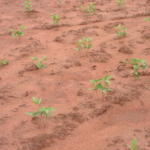


Institut de l'Environnement et de Recherches Agricoles
University of Nebraska-Lincoln
Burkina Faso
11/2010—11/2014
The Soil and water conservation project endeavors to determine management principles relevant to West Africa that increase soil organic matter in order to improve soil water and nutrient levels, improve water use efficiencies, increase farmer sorghum grain and stover yields, and thereby reverse soil degradation, contribute to mitigation of climate change, and increase farmer profitability. An interdisciplinary team involving agronomists, soil scientists, and agricultural economists cooperates with farmer’s groups and the local extension service to test the following research hypotheses:Interaction of zaï and tied ridges, compost and chemical fertilizer application, and leaving crop residues in the field will improve soil quality as measured by soil organic matter, nutrient levels and water holding capacity thereby contributing to climate change mitigation.Interaction of zaï and tied ridges, compost and chemical fertilizer application, and leaving crop residues in the field will increase water use efficiency by increasing grain and stover yields.Interaction of zaï and tied ridges, compost and chemical fertilizer application, and leaving crop residues in the field improve profitability and labor utilization, reduce risk, and reinvestment of increased profits will improve sustainability of the system.On-station and on-farm experimentation is complemented by surveys of on-farm research partners and field day participants, to provide insight into farmer perception of the new management practices, to assist with future adoption efforts. Capacity development will benefit INERA scientists in soil water and climate data collection and interpretation, statistical analysis of data, and scientific manuscript preparation. Further capacity building will be achieved via integration of local University students who will conduct their theses research in the project.
Determine the interactive effects of micro-catchment basins, crop residue, compost and chemical fertilizer management on soil (nutrient and water) attributes, water use efficiency, grain and stover yields, profitability, risk, labor and reinvestment of increased profits, and relate these to soil degradation and quality, sustainability, profitability and mitigation of climate change.Determine the profitability, risk and reinvestment potential of tillage and soil amendments for poor, resource farmers Sahelian, Sudano-Sahelian and Sudanian agro-ecological zones.Increase INERA scientific capability on (1) soil water and climate measurement and interpretation, (2) management and interpretation of historical weather station data, (3) crop simulation modeling, (4) statistical analysis. In addition, the project will strengthen the capability of University of Ouagadougou student’s education by supervising undergraduate and M.S. theses with research conducted with this research project.Three on-station experiments with sole cereal crop (sorghum or millet) were conducted at Kamboinsé (Soudano sahelian zone), Nadion (Soudanian zone) and Dori (Sahelian zone).One cereal/legume association experiment was conducted at Kamboinsé. Data analysis is still underway but preliminary results suggest that the zaï wholes and minimum tillage result in best water conservation, while compost application in combination with limited fertilizer application and crop residue management result in best soil fertility restoration.Three technicians were trained in soil water and climate measurement and interpretation.
During year two, tied ridging practices gave better results in term of soil water storage compared to minimum tillage, ripping and conventional tillage. Overall tied ridging and conventional tillage practices have reduced soil density by increasing soil porosity compared to minimum tillage and ripping practices. Mulching practice has also improved soil moisture storage capacity both at 20cm and 40 cm depth during the cropping seasonBoth tillage practices and fertility management options affected soil nitrate – nitrogen content during the cropping season. Soil nitrate – N content increased under tied ridging and conventional tillage practices during the peak rainfall period while it did not show much variation under zero tillage and ripping practicesSorghum grain uptake of N, P and K was higher under compost + NPK + urea treatment followed by NPK + urea treatment. The lowest nutrient uptake values were observed under mulching practice. Biomass total N, P and K uptake by sorghum also followed the same pattern as the grain N, P and K uptake (see tables below). The total N, P and K uptakes were similarly affected by fertility management options in a decreasing trend of compost + NPK + urea > NPK + urea > compost > control > mulchingApplication of compost + mineral fertilizer + crop residues produced higher sorghum grain yields under all water management practices, except for the tie-ridging technique where higher grain yield was observed with the application of compost + mineral fertilizer. The lowest yields occurred in all water management techniques when plots were not fertilized (control), except for the scarifying where yields were lower with application of crop residuesGenerally, higher grain yields of grain sorghum produced in Kamboinsé occurred with application of compost + mineral fertilizer + crop residues in all four years. The lowest yields were observed when no fertilizer was applied in all four yearsThe application of either compost + mineral fertilizer or compost +mineral fertilizer + crop residues resulted in higher grain yields of grain sorghum produced in sole cropping system at Nadion in all four years. The lowest yields occurred in plots receiving crop residues in all years, except for the year 2011 where lower yield occurred in plots with no fertilizer applied.
